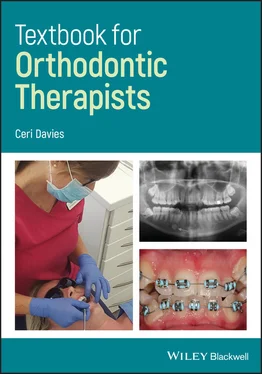The most commonly found supernumerary is in the anterior maxillary region.
The types that can be found are conical, also known as mesiodens, tuberculate, supplemental, and odontomes.
4.3.1.3 Early Loss of Deciduous Teeth
There could be numerous reasons for early loss of deciduous teeth.
Common causes could be caries, trauma, or root resorption.
Early loss could result in crowding and space loss, which could possibly lead to impaction.
For example, early loss of a lower deciduous E can result in mesial movement of the lower first molar, making no space for the lower premolar to erupt, resulting in impaction.
4.3.1.4 Extraction of Permanent Tooth
Most commonly a first permanent molar.
Extraction of a first permanent molar can result in crowding and space loss, which could possibly lead to impaction.
Reasons for a first permanent tooth being extracted could be poor diet and oral hygiene, which can lead to caries.
4.3.2 Variation in Tooth Size
4.3.2.1 Macrodont
A large tooth is known as a macrodont.
This tooth will present with a large clinical crown.
Macrodonts can be associated with supernumaries.
A clinical feature that can result from macrodonts is dental crowding.
A small tooth is known as a microdont.
This tooth will present with a small clinical crown.
Microdonts can often be associated with hypodontia.
A clinical feature that can result from microdonts is spacing.
4.3.2.3 Dento‐alveolar Disproportion
This is a term that relates to the teeth and jaws.
Dento‐alveolar disproportion is found when there is a mismatch in tooth and jaw size.
For example, patients could present with big jaws but small (microdontia) teeth or small jaws and big (macrodontia) teeth.
The clinical result that can be found with this is crowding or spacing.
4.3.2.4 Bolton Discrepancy
This is an analysis which determines the size discrepancy between the size of the maxillary and mandibular teeth.
It looks at the mismatch in tooth size and helps to analyse the optimum inter‐arch relationship.
Measurements are taken of the mesio and distal widths of all the teeth.
This analysis was developed to achieve the ideal occlusion and inter‐digitation.
4.3.3 Variation in Tooth Position
4.3.3.1 Infraocclusion (Ankylosis)
Infraocclusion is also known as ankylosis.
Ankylosis is when failure of eruption of a tooth occurs due to the anatomical fusion of cementum and alveolar bone.
When a tooth is ankylosed, the tooth will submerge relative to its neighbours. It is important to know that when this happens the tooth is not sinking, its neighbouring teeth are erupting alongside the alveolar complex.
The most commonly affected deciduous teeth are the first and second deciduous molars (Ds and Es).
The most common cause of this is genetic and the condition has a high occurrence in patients with hypodontia.
This is a term used to describe a certain type of eruption of a tooth.
An ectopic tooth is a tooth that manages to erupt, but may erupt at an angle or in an aberrant position, rather than emerging in its correct position.
Impaction occurs when there is failure of eruption due to an obstruction such as tissue, bone, or another tooth.
It occurs mostly when crowding is present.
The most common teeth that are impacted are the upper canines (U3s), upper central incisors (U1s), and lower first permanent molars (L6s).
Transposition is a term used when the anatomical positions of teeth are interchanged.
The most commonly affected teeth are the maxillary canines and first premolars and mandibular lateral incisors and mandibular canines.
There are two types of transposition:True transposition is found when the roots and crowns of the teeth have completely interchanged.False transposition is found when the roots are in the correct position but the crowns have interchanged.
4.3.3.5 Primary Failure of Eruption
This is seen when a tooth fails to fully erupt.
It usually has a strong genetic basis.
The most commonly affected teeth are the first and second permanent molars.
A thumb or finger sucking habit may exist until at least the age of 6–7 years. It can have a significant effect on occlusion, depending on the duration and intensity. Forces (intensity of the habit) acting more than six hours a day result in tooth movement such as:
AOB
Increased overjet
Buccal crossbites.
4.5 Fraenal Attachments
4.5.1 Upper Labial Fraenum
Patients who have a low fraenal attachment may present with a maxillary midline diastema.
If the patient has an alveolar cleft between the incisors, a fraenectomy may be needed at the end of treatment.
If the patient does not have a fraenectomy, this can result in the diastema reopening post‐treatment.
4.5.2 Lower Labial Fraenum
A lower fraenal attachment can result in the following:
Diastema
Poor oral health
Recession at the gingival margin.
5 Class I Malocclusion
5.1 Definition
The lower incisor edges occlude with or lie immediately below the cingulum plateau of the upper central incisors.
Fifty per cent of Caucasians present with this type of occlusion.
5.3 Aetiology of Class I
5.3.1 Skeletal Factors
Patients can present with either a skeletal Class I, II, or III.
They can present with dento‐alveolar compensation, when they will have the following features:Can be a skeletal II or III.Skeletal II = upper incisors retroclined and lower incisors proclined.Skeletal III = upper incisors proclined and lower incisors retroclined.
Average, increased, or decreased lower anterior facial height (LAFH).
Mandibular asymmetry or narrow maxilla can result in crossbites.
5.3.2 Soft Tissue Factors
Patients usually have favourable soft tissues.
They could present with bimaxillary proclination, a term used to describe the proclination of the upper and lower incisors.
Features found with bimaxillary proclination are:Weak muscular toneIncompetent lipsForward tongue positionMacroglossia tongue.
Dento‐alveolar disproportion can result in crowding or spacing.
Early loss of deciduous teeth can result in a centreline displacement.
When there is crowding, teeth can become impacted, such as maxillary canines, maxillary central incisors, first permanent molars or premolars due to early loss of deciduous first molars (Ds) and secondary molars (Es).
When there is spacing, the ‘ugly duckling’ stage can be seen when maxillary canines are not erupted. Once the canines have erupted this is usually self‐correcting. Patients can present with a diastema due to:Missing lateralsMicrodontSupernumeraryLow fraenal attachment
Proclined incisors.
There are five ways in which a class I malocclusion can be treated.
Leave the malocclusion and accept the teeth, and their discrepancies, as they are.
All patients must be informed of all the risks if they wish to take the no treatment option.
Читать дальше












